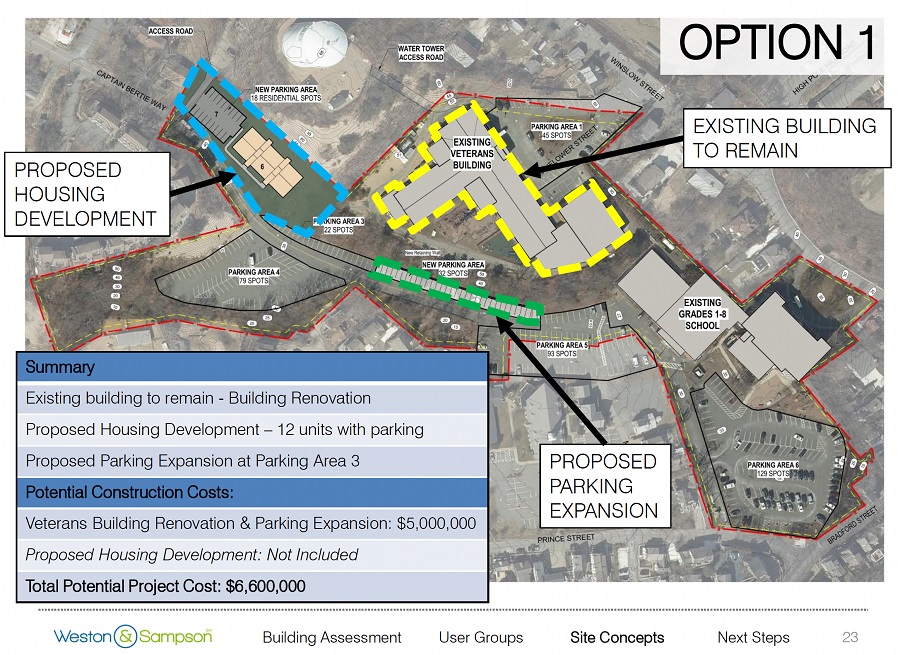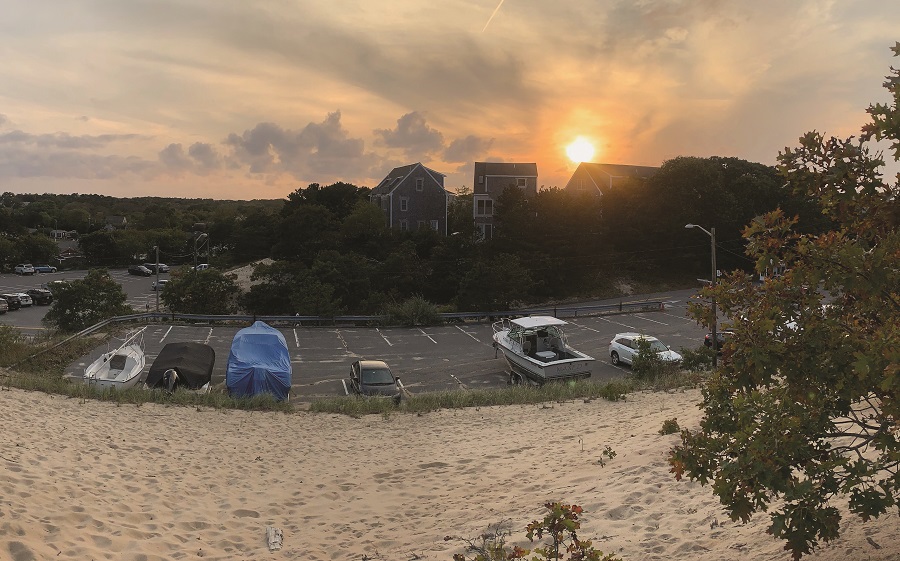PROVINCETOWN — Engineers from the municipal contractor Weston & Sampson told the select board on March 27 that the town had three options for rebuilding the Veterans Memorial Community Center (VMCC) into a newer municipal building and new housing. They would cost between $36 million and $72 million.

But their top recommendation, called “Option One,” would be easier and less expensive: renovate the building instead of replacing it and pave the way for housing on a small parking lot on the property for around $6.6 million.
“I think we can take Option One, get something done faster, and that’s great,” said board member Leslie Sandberg. The rest of the board agreed, although they criticized the engineering report’s limitations.
“This is such a robust site for us to develop,” said member Louise Venden, “and it was my hope that we would be more imaginative and resourceful in figuring out what additional kinds of things we could put here. But obviously that isn’t what happened here.”
The Weston & Sampson presentation concluded the first phase of a study town meeting authorized a year ago. Last April, the town passed Article 21, which allocated $150,000 to study how best to redevelop the VMCC and its surrounding parking lots to meet needs for both housing and municipal spaces.

J.P. Parnas, the Weston & Sampson engineer who presented “Option One,” described it this way: The 37 parking spaces closest to Captain Bertie’s Way, which are downhill from the town’s main water tank, could be replaced with 32 new spaces further south by cutting into the slope in that region and adding a retaining wall. That would free up the northwest parking lot for new housing with its own dedicated parking, Parnas said.
The $6.6-million plan would include the retaining wall, the new spaces, and a package of renovations to the VMCC building but not the eventual cost of a housing project at the former parking lot, Parnas said.
The other three options presented by the consultants all involved bulldozing the existing community center, home of the council on aging, the recreation dept., dept. of public works, and the Provincetown Schools’ kindergarten classrooms.
Options Two and Three envisioned a two-story reconstruction of the one-story community center, which would free up room for parking at the site and therefore room to add housing on nearby parking lots.
A three-story community center with housing on its third floor and no other changes to the surrounding lots was presented as Option Four, with an estimated price of $72 million.
The select board was enthusiastic about building housing on the northwest parking lot — a project that would not have to affect the VMCC at all and could move forward relatively quickly, members said.

“I like the idea that we’re turning a parking lot at the bottom of the hill into a housing site,” said select board chair Dave Abramson, “but I don’t want to see a big renovation that’s going to stick us into this building for 20 or 30 years.”
“We found a new spot for housing,” said Sandberg. “But we still have this huge area, and you could go up pretty high, three stories,” and not affect the sightlines of neighboring buildings, she added.
Town Manager Alex Morse pointed out that the report also included a current-use analysis of the VMCC that found the building was well used by residents of all ages, from senior citizens to the town’s early-childhood program.
“There are things that need to be there that we can’t just find another place for, and I think we have an opportunity to make the existing VMCC last longer with a small investment,” Morse said.
Option One has 12 townhouses with 18 parking spaces sited at the northwest parking lot, but Morse said that number was just a placeholder.
“When I first saw that, I said, ‘That’s not enough units,’ ” Morse said. He added that once the northwest parking lot is divided into its own separate parcel it would be easier to have a detailed discussion about density and unit count.
At present, the VMCC, the Provincetown Schools building, and five town parking lots all share the same 11.7-acre parcel. The northwest parking lot would come in at just under an acre, judging by the town’s documents, although a precise number was not provided in the report.
The town’s building committee, which was created to help shepherd a police station into existence, also spoke with Weston & Sampson’s engineers and with the town departments that work at the VMCC, chair Jeffrey Mulliken told the select board. Their conclusion was that relocating departments from the building during construction would be very difficult and that the building itself was in reasonable shape for continued use, assuming normal maintenance, Mulliken said.
Opportunity Zone Financing
Mulliken also told the board that he, planning board chair Dana Masterpolo, and two other people he did not identify were researching the possibility of enticing private investors to finance a market-rate rental housing project through the “opportunity zones” that were created in the 2017 tax law passed in the first year of the Trump presidency. Provincetown is the only opportunity zone on the Lower or Outer Cape.
“An opportunity zone is a place where wealthy people, people with large capital gains, can shield those capital gains from taxes,” Mulliken said. “The goal would be to build very high-density market-rate rental housing, because that creates a building that has income that an investor might be interested in joining.
“We’re in the very early stages, working out a proof of concept on this,” Mulliken added. “It would require some zoning relief for density. But I wanted to get it out on the table, and we could come back to you in two or four weeks and talk about it more.”
The board’s reception was cautious, although Morse pointed out that the town is hoping to build all market-rate rentals at the former police station site at 26 Shank Painter Road. “We’re likely to need local money and local interest,” Morse said, because the town won’t be seeking state and federal financing for that project.
Mulliken later told the Independent that he and Masterpolo, who each chair relevant committees, would not be financially involved in such an effort. He said he was not yet ready to identify the other two people.
“We’re starting out with a concept here, we have a lot of investigation to do, and this would have to be sanctioned by the town,” Mulliken said. “Dana and I are not developers — we’re just looking at this idea to see if it works.”
